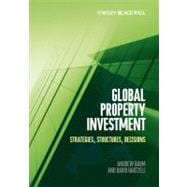The measurement, benchmarking, forecasting and quantitative management techniques applied to property investments are now compatible with those used in other asset classes, and advances in property research have at last put the ongoing debate about the role of real estate onto a footing of solid evidence.
The truly global scope and authorship of this book is unique, and both authors here are singularly well qualified to summarise the impact and likely future of global innovations in property research and fund management. Between them, they have experienced three real estate crashes, and have observed at first hand the creation of the real estate debt and equity instruments that led to the global crisis of 2008-9.
Global Property Investment: strategies, structure, decisions offers a unique perspective of the international real estate investment industry with:
- a close focus on solutions to real life investment problems
- no excessive theoretical padding
- a target of both students and professionals
- highly qualified dual-nationality authorship
With many cases, problems and solutions presented throughout the book, and a companion website used for deeper analysis and slides presentations (see below), this is a key text for higher-level real estate students on BSc, MSc, MPhil and MBA courses worldwide as well as for practising property professionals worldwide in fund management, investment and asset management, banking and real estate advisory firms.








